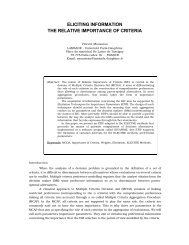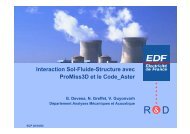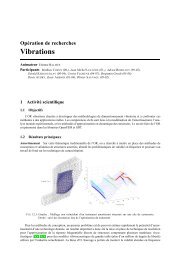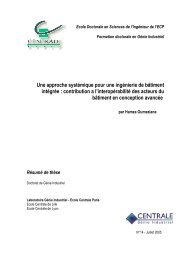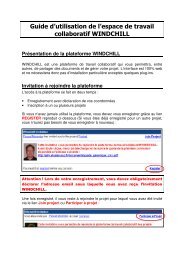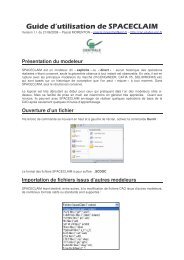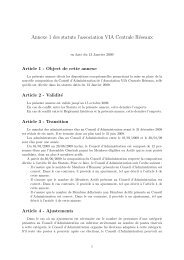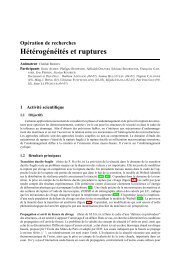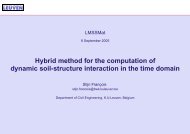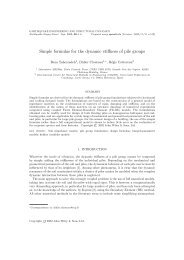6 Authors Suppressed Due to Excessive Lengththe cluster must be more connected with inside nodes, than with nodes outsideof the cluster (see found [5] and [6] for extended reviews).The first class of clustering algorithms are the partitional algorithms, whichtry to find a partition of a set of data, with a given number of clusters, usingjointly, most of the times, similarity or a dissimilarity measures and a qualitycriterion of the found partition. The most popular partitional algorithm (withseveral variants), the k-means clustering [7], tries to find a partition of the setof objects which minimizes the sum-of-square criterion which adds the dissimilaritiesfrom each object to the centre of its own cluster. Several (di)similaritymeasures can be defined in the social network context, like those based on theJaccard index, which measures similarity between the sets of neighbours of thetwo nodes, but other measures can be defined ([5] and [6]).Hierarchical clustering algorithms try to organize data into a hierarchicalstructure, and are divided into agglomerative and divisive algorithms, dependingon whether the partition is coarsened, or refined, at each iteration. The basicidea beyond agglomerative algorithms is simple: at the starting point, the objectsto cluster are their own classes, and then at each stage we merge the twomore similar clusters. Of course a dissimilarity measure between two clustersis mandatory, and for a given dissimilarity measure d between objects, severalcluster-dissimilarities exist. The result of the clustering process is a dendrogram,which can be cut to give one single partition. Divisive clustering algorithms,split the dataset iteratively or recursively into smaller and smaller clusters, withrespect to a quality criterion. The most popular method for divisive hierarchicalclustering of social networks uses the notion of edge betweenness [8], becausefinding the connecting edges between communities is also finding these communities.The algorithm given in [4] splits the network into clusters by removing,stepafterstep,theedgewiththehigherbetweennessvalue.Theuseofastoppingcriterion which measures the improvement at each step should permit to stopwhen no improvement is gained with an iteration. In most cases the modularity[9] is used. SuperGraph [28] employs hierarchical graph partitioning to visualizelarge graphs.Specially designed for graphs, spectral algorithms [10] are based on the notionof connected components. These algorithms work with a Laplacian, matrixbased onthe adjacency (or weight) matrix [11] [12]. If the graph of the socialnetwork contains k , completely disjoints communities (i.e. without any link betweenthem), called connected components, then the k eigenvectors associatedto the eigenvalue 0 are indicator vectors of the k connected components . Ifthe clusters of the social network do not contain “clean” connected components(i.e. if there are links between existing communities), then a simple clusteringon the k eigenvectors associated to the k least eigenvalues, can retrieve the kcommunities.Some other algorithms works on graph aggregation use statistical methods tostudy graph characteristics, such as degree distributions [26], hop-plots [27] andclustering coefficients [30]. The results are often useful but difficult to controland especially to exploit. Methods for mining frequent graph patterns [32] are
DB2SNA: Extraction and Aggregation of Social Networks from DB 7also used to understand the characteristics of large graphs. Washio and Motoda[26] provide an elegant review on this topic.However, all the previous algorithms use only on links between nodes of thegraph of the network, and do not take into account the internal values containedin each node, while classical clustering algorithms applied on tables of values,work only on these values ignoring completely the possible link between individual.Analgorithmwhichcantakeintoaccountbothkindofinformationwouldbevery valuable. Designed for graphical graph aggregation the k-SNAP algorithm[29], in its divisive version, begins with a grouping based on attributes of thenodes, and then tries to divide the existing groups thanks to their neighboursgroups, trying minimizing a loss information measure.3 Social Network extraction from relational databasesIn this section we describe our approach of graph extraction which is based ontwo steps. The first step to perform is to transform relational databases intograph databases according to a graph model.This transformation allows the extraction of all the entities in the relationaldatabase on the form of nodes and outlines the relations between them whichfacilitate, in further steps, the selection of the desired entities. Also, nodes ingraph database are more complex than a simple graph which can encapsulate allthe attribute of entities in the same node and give us a simple graph of entities.The second step is to define a method to transform the graph according tochosen entities. This method has to deal with the identification of entities ofinterest for a particular user and to reorganize the graph – nodes and relationships– according to this point of view. Then, we applied this approach to extractsocial network.3.1 Graph extractionThe graph extraction approach is based on two main steps: (1) converting therelational database into graph database and (2) Extracting the heterogeneousgraph (with chosen entities) from the graph database.Converting relational database into hypernode database Havingagraphdatabase instead of a relational database will provide a clearer view of existingobjects in the initial database. Indeed, all these objects will be presented in theform of nodes, and the relations between them will be outlined thus facilitatingthe selection of the desired objects of interest in a further step. In addition,nodes in a graph database can encapsulate all the attributes of objects in thesame node and give us a simple graph of objects.Using the comparison between existing graph database models (Table 1),we have chosen to work with the hypernode model [19] because the hypernodedatabase with its nested graphs can provide an efficient support to representeach real-world object as a separate database entity.



